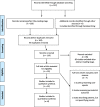Clinical effectiveness of Invisalign® orthodontic treatment: a systematic review
- PMID: 30264270
- PMCID: PMC6160377
- DOI: 10.1186/s40510-018-0235-z
Clinical effectiveness of Invisalign® orthodontic treatment: a systematic review
Abstract
Background: Aim was to systematically search the literature and assess the available evidence regarding the clinical effectiveness of the Invisalign® system.
Methods: Electronic database searches of published and unpublished literature were performed. The reference lists of all eligible articles were examined for additional studies. Reporting of this review was based on the Preferred Reporting Items for Systematic Reviews and Meta-Analyses (PRISMA) guidelines.
Results: Three RCTs, 8 prospective, and 11 retrospective studies were included. In general, the level of evidence was moderate and the risk of bias ranged from low to high, given the low risk of bias in included RCTs and the moderate (n = 13) or high (n = 6) risk of the other studies. The lack of standardized protocols and the high amount of clinical and methodological heterogeneity across the studies precluded a valid interpretation of the actual results through pooled estimates. However, there was substantial consistency among studies that the Invisalign® system is a viable alternative to conventional orthodontic therapy in the correction of mild to moderate malocclusions in non-growing patients that do not require extraction. Moreover, Invisalign® aligners can predictably level, tip, and derotate teeth (except for cuspids and premolars). On the other hand, limited efficacy was identified in arch expansion through bodily tooth movement, extraction space closure, corrections of occlusal contacts, and larger antero-posterior and vertical discrepancies.
Conclusions: Although this review included a considerable number of studies, no clear clinical recommendations can be made, based on solid scientific evidence, apart from non-extraction treatment of mild to moderate malocclusions in non-growing patients. Results should be interpreted with caution due to the high heterogeneity.
Keywords: Aligner; Clinical efficiency; Invisalign; Orthodontics.
Conflict of interest statement
Ethics approval and consent to participate
Ethical approval was not required.
Consent for publication
Not applicable.
Competing interests
The authors declare that they have no competing interest.
Publisher’s Note
Springer Nature remains neutral with regard to jurisdictional claims in published maps and institutional affiliations.
References
-
- Boyd RL. Esthetic orthodontic treatment using the Invisalign® appliance for moderate to complex malocclusions. J Dent Educ. 2008;72(8):948–967. - PubMed
Publication types
MeSH terms
LinkOut - more resources
Full Text Sources
Other Literature Sources
Medical


